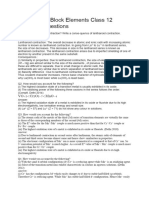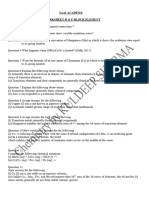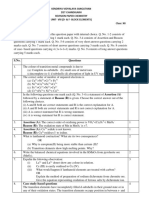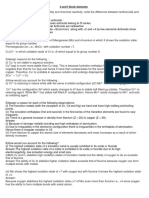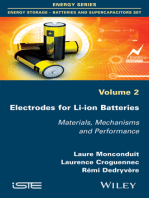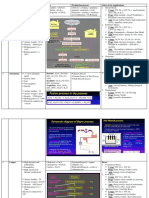CH-8 d and f block elements
Uploaded by
maqbool.1978CH-8 d and f block elements
Uploaded by
maqbool.1978CH-8 ( d and f block elements)
Q.112 What is meant by ‘lanthanoid contraction’? (Delhi 2011)
Answer:
The steady decrease in the ionic radius from La3+ to Lu3+ is termed as lanthanoid
contraction.
Q.113 What happens when (NH4)2Cr2O7 is heated? (Delhi 2017)
Answer:
Q.114 Explain the following observations :
(i) Generally there is an increase in density of elements from titanium (Z = 22) to copper
(Z = 29) in the first series of transition elements.
(ii) Transition elements and their compounds are generally found to be good catalysts in
chemical reactions. (Delhi 2010)
Answer:
(i) From titanium to copper the atomic size of elements decreases and mass increases
as a result of which density increases.
(ii) The catalytic properties of the transition elements are due to the presence of
unpaired electrons in their incomplete d- orbitals and variable oxidation states.
Q.115 Explain the following observations :
(i) Transition elements generally form coloured compounds.
(ii) Zinc is not regarded as a transition element. (Delhi 2010)
Answer:
(i) Because of presence of unpaired d electrons, which undergoes d-d transition by
absorption of energy from visible region and then the emitted light shows
complementary colours. This is how transition elements form coloured compounds.
(ii) Zinc in its common oxidation state of +2 has completely filled d-orbitals. Hence
considered as non-transition element.
Q.116 Assign reasons for each of the following :
(i) Transition metals generally form coloured compounds.
(ii) Manganese exhibits the highest oxidation state of +7 among the 3d series of
transition elements. (Delhi 2011)
Answer:
(i) Because presence of unpaired d electrons, which undergoes d-d transition by
absorption of energy from visible region and then the emitted light shows
complementary colours.
(ii) Manganese exhibits highest oxidation of +7 among 3d series of transition elements
because all the oxidation states are exhibited from +2 to +7 by Mn and no other element
of this series shows this highest state of oxidation.
Q.117 Complete the following chemical equations : (All India 2011)
(i) MnO4 (aq) + S2O32- (aq) + H2O (1) →
(ii) Cr2O72- (aq) + Fe2+ (aq) + H+ (aq) →
Answer:
Q.118 Explain giving a suitable reason for each of the following :
(i) Transition metals and their compounds are generally found to be good catalysts.
(ii) Metal-metal bonding is more frequent for the 4d and the 5d series of transition
metals than that for the 3d series. (All India 2011)
Answer:
(i) The catalytic properties of the transition elements are due to the presence of
unpaired electrons in their incomplete d- orbitals and variable oxidation states.
(ii) Metal-metal bonding is more frequent for the 4d and the 5d series of transition
metals than that for the 3d series as these have their electrons of outer most shell at
greater distance from the nucleus, as compared to atoms of 3d transition metals.
Q.119 What is Lanthanoid contraction? What are its two consequences? (Comptt. Delhi
2013)
Answer:
Lanthanoid contraction: The overall decrease in atomic and ionic radii with increasing
atomic number is known as lanthanoid contraction. In going from La+3 to Lu+3 in
lanthanoid series, the size of ion decreases. This decrease in size in the lanthanoid
series is known as lanthanoid contraction. The lanthanoid contraction arises due to
imperfect shielding of one 4f electron by another present in the same subshell.
Consequences :
(i) Similarity in properties: Due to lanthanoid contraction, the size of elements which
follow (Hf – Hg) are almost similar to the size of the elements , of previous row (Zr – Cd)
and hence these are difficult to separate. Due to small change in atomic radii, the
chemical properties of lanthanoids are very similar due to which separation of
lanthanoid becomes very difficult.
(ii) Basicity difference : Due to lanthanoid contraction, the size decreases from La +3 to
Lu+3. Thus covalent character increases. Hence basic character of hydroxides also
decreases i.e. why La(OH)3 is most basic while Lu(OH)3 is least basic.
Q.120 Assign a reason for each of the following observations:
(i) The transition metals (with the exception of Zn, Cd and Hg) are hard and have high
melting and boiling points.
(ii) The ionization enthalpies (first and second) in the first series of the transition
elements are found to vary irregularly. (Comptt. Delhi 2014)
Answer:
(i) Because of stronger metallic bonding and high enthalpies of atomization.
(ii) Due to irregulaties in the electronic configuration there is irregularities in the
enthalpies of atomisation. Hence there is irregular variation in I.E.
Q.121 Assign reason for each of the following :
(i) Transition elements exhibit paramagnetic behaviour.
(ii) Co2+. is easily oxidised in the presence of a strong ligand. (Comptt. Delhi 2014)
Answer:
(i) Because of presence of unpaired electrons in their d-subshell in atomic and ionic
state.
(ii) Co2+ ion is easily oxidised to Co3+ ion in presence of a strong ligand because of its
higher crystal field energy which causes pairing of electrons to give inner orbital
complexes (d2sp3).
Q.122 Assign reasons for the following :
(i) Transition metals and many of their compounds act as good catalysts.
(ii) Transition metals generally form coloured compounds. (Comptt. All India 2014)
Answer:
(i) The catalytic properties of the transition elements are due to the presence of
unpaired electrons in their incomplete d-orbitals and variable oxidation states.
(ii) Because of presence of unpaired electrons in d-orbital, which undergoes d-d
transition by absorption of energy from visible region and then the emitted light shows
complementary colours.
Q.123 Give reasons :
(i) Zn is not regarded as a transition element.
(ii) Cr2+ is a strong reducing agent. (Comptt All India 2016)
Answer:
(i) Zinc Atomic no. 30 have EC 3d10, 4s2. It has completely filled ‘d’ orbitals.
(ii) Cr+2 (3d4) after loosing one electron forms Cr+3 (d3). It has t32ge0g configuration.
Hence more stable. Hence Cr+2 acts as reducing agent.
Or
Cr+3 is more stable than Cr+2, therefore Cr+2 looses one electron. Hence acting as strong
reducing agent.
Q.124 How would you account for the following?
(i) Many of the transition elements are known to form interstitial compounds.
(ii) The metallic radii of the third (5d) series of transition metals are virtually the same as
those of the corresponding group members of the second (4d) series.
(iii) Lanthanoids form primarily +3 ions, while the actinoids usually have higher oxidation
states in their compounds, +4 or even +6 being typical. (Delhi 2012)
Answer:
(i) The transition metals form a large number of interstitial compounds in which small
atoms such as hydrogen, carbon, boron and nitrogen occupy the empty spaces in the
crystal lattices of transition metals.
(ii) Because of lanthanoid contraction.
(iii) This is due to comparable energies of 5f, 6d, 7s orbitals in actinoids.
Q.125 Give reasons :
(a) There is a gradual decrease in the size of atoms with increasing atomic number in
the series of lanthanoids.
(b) Sc (21) is a transition element but Ca (20) is not.
(c) The Fe2+ is much more easily oxidised to Fe2+ than Mn2+ to Mn3+. (Comptt. Delhi
2012)
Answer:
(a) This is due to lanthanoid contraction.
(b) Sc (21) is regarded as a transition element due to the presence of incomplete d-
subshell (3d14s2) but Ca (20) does not have any d-subshell.
(c) Fe+2[Ar] 3d6 can be easily oxidised to Fe+3 [Ar] 3d5, which is half filled and is more
stable but Mn+2 is d5 in configuration which is again half filled configuration and Mn+3 is
d4 in configuration.
Q.126 (i) Name the element of 3d transition series which shows maximum number of
oxidation states. Why does it show so?
(ii) Which transition metal of 3d series has positive E0(M2+/M) value and why?
(iii) Out of Cr3+ and Mn3+, which is a stronger oxidizing agent and why?
(iv) Name a member of the lanthanoid series which is well known to exhibit +2 oxidation
state.
(v) Complete the following equation :
MnO4– + 8H+ + 5e– → (Delhi 2014)
Answer:
(i) Mn has the maximum number of unpaired electrons present in the d-subshell (5
electrons). Hence, Mn exhibits the largest number of oxidation states, ranging from +2
to +7.
(ii) Copper has positive E0(Cu2+/Cu) value because of its high enthalpy of atomization
and low enthalpy of hydration. The high energy required to oxidise Cu to Cu2+ is not
balanced by its hydration energy.
(iii) Cr2+ has the configuration 3d4 which easily changes to d3 due to stable half filled t2g
orbitals. Therefore Cr2+ is reducing agent, it gets oxidized to Cr3+. While Mn2+ has stable
half filled d5 configuration. Hence Mn3+ easily changes to Mn2+ and acts as oxidising
agent.
(iv) Eutropium is well known to exhibit +2 oxidation state.
(v) MnO4– + 8H+ + 5e– → Mn2+ + 4H2O
Q.127 The elements of 3d transition series are given as:
Se Ti V Cr Mn Fe Co Ni Cu Zn
Answer the following:
(i) Write the element which shows maximum number of oxidation states. Give reason.
(ii) Which element has the highest m.p.?
(iii) Which element shows only +3 oxidation state?
(iv) Which element is a strong oxidizing agent in +3 oxidation state and why? (All India)
Answer:
(i) Mn shows, maximum number of oxidation states upto +7. It has the maximum
number of unpaired electrons.
(ii) Cr has the highest melting point.
(iii) Sc shows only +3 oxidation state.
(iv) Mn is a strong oxidizing agent in +3 oxidation state because after reduction it attains
+2 oxidation state in which it has the most stable half-filled (d5) configuration
You might also like
- Questions 3rd Geologya and Ch. Applied 2023 PDFNo ratings yetQuestions 3rd Geologya and Ch. Applied 2023 PDF20 pages
- important-question-class-12-chemistry-chapter-4-2No ratings yetimportant-question-class-12-chemistry-chapter-4-29 pages
- important-question-class-12-chemistry-chapter-4-2No ratings yetimportant-question-class-12-chemistry-chapter-4-213 pages
- Important question of d and f block elementsNo ratings yetImportant question of d and f block elements8 pages
- important-question-class-12-chemistry-chapter-4-2.docxNo ratings yetimportant-question-class-12-chemistry-chapter-4-2.docx10 pages
- IMPORTANT QUESTIONS FROM PREVIOUS PAPERS DfgdhfgnhfjghjghdhtyNo ratings yetIMPORTANT QUESTIONS FROM PREVIOUS PAPERS Dfgdhfgnhfjghjghdhty27 pages
- Important Questions For CBSE Class 12 Chemistry From CBSETUTSNo ratings yetImportant Questions For CBSE Class 12 Chemistry From CBSETUTS25 pages
- COMPILED-2023-24 - d AND f BLOCK ELEMENTSNo ratings yetCOMPILED-2023-24 - d AND f BLOCK ELEMENTS4 pages
- 21 - 59 - 21 - 11 - 12 - 2023 - Chapter 8 - D and F Block Ncert Exercise QuestionsNo ratings yet21 - 59 - 21 - 11 - 12 - 2023 - Chapter 8 - D and F Block Ncert Exercise Questions15 pages
- d and f block-Important board questions with answersNo ratings yetd and f block-Important board questions with answers6 pages
- Chapter 4 the d and f Block Elements PYQ (1)No ratings yetChapter 4 the d and f Block Elements PYQ (1)27 pages
- Revision Paper Chem-12, Unit-Viii, 2022-23No ratings yetRevision Paper Chem-12, Unit-Viii, 2022-232 pages
- D and F Block Question Bank (Subjective)No ratings yetD and F Block Question Bank (Subjective)11 pages
- Chemistry Question Bank 2023 Class 12-Copy ExportNo ratings yetChemistry Question Bank 2023 Class 12-Copy Export105 pages
- D and F Block Elements Previous Year QuestionsNo ratings yetD and F Block Elements Previous Year Questions3 pages
- Chapter 4 – Important Questions and AnswersNo ratings yetChapter 4 – Important Questions and Answers3 pages
- d & f block elements- Reasoning questionsNo ratings yetd & f block elements- Reasoning questions10 pages
- Electrodes for Li-ion Batteries: Materials, Mechanisms and PerformanceFrom EverandElectrodes for Li-ion Batteries: Materials, Mechanisms and PerformanceNo ratings yet
- Study of Limit Concentrations of DBDS and Sulfur Mercaptan in Power TransformersNo ratings yetStudy of Limit Concentrations of DBDS and Sulfur Mercaptan in Power Transformers3 pages
- Chemical Treatment of Crystalline Silicon Solar Cells As A Method of Recovering PureNo ratings yetChemical Treatment of Crystalline Silicon Solar Cells As A Method of Recovering Pure9 pages
- 12TH CHEMISTRY (DPQ-COORDINATION COMPOUND NCERT)30.05.24-1_32810479-0d89-4910-9664-f14d46856608No ratings yet12TH CHEMISTRY (DPQ-COORDINATION COMPOUND NCERT)30.05.24-1_32810479-0d89-4910-9664-f14d4685660810 pages
- Fatal Suicidal Case of Cyanide Poisoning A Case Report O6IgNo ratings yetFatal Suicidal Case of Cyanide Poisoning A Case Report O6Ig2 pages
- No Nama Bahan Satuan: Pengadaan Bahan Kimia Laboratorium Dinas Lingkungan Hidup Kabupaten Lebak Tahun 2022No ratings yetNo Nama Bahan Satuan: Pengadaan Bahan Kimia Laboratorium Dinas Lingkungan Hidup Kabupaten Lebak Tahun 20224 pages
- 9th Icse Chemical Changes and Reaction Test 12No ratings yet9th Icse Chemical Changes and Reaction Test 124 pages
- Gr9 Chemistry Chapter 1 - Language of ChemistryNo ratings yetGr9 Chemistry Chapter 1 - Language of Chemistry7 pages
- Welding Requirements: Suggestions For Welding Stainless SteelNo ratings yetWelding Requirements: Suggestions For Welding Stainless Steel7 pages
- In Partial Fulfillment For The Award of The Degree ofNo ratings yetIn Partial Fulfillment For The Award of The Degree of11 pages
- Worksheet 5.1: Kinetic Theory and The General Gas EquationNo ratings yetWorksheet 5.1: Kinetic Theory and The General Gas Equation4 pages
- Tutorial 5 - Entropy and Gibbs Free EnergyNo ratings yetTutorial 5 - Entropy and Gibbs Free Energy3 pages
- March 2017 (v2) QP - Paper 2 CIE Chemistry IGCSENo ratings yetMarch 2017 (v2) QP - Paper 2 CIE Chemistry IGCSE16 pages
- important-question-class-12-chemistry-chapter-4-2.docximportant-question-class-12-chemistry-chapter-4-2.docx
- IMPORTANT QUESTIONS FROM PREVIOUS PAPERS DfgdhfgnhfjghjghdhtyIMPORTANT QUESTIONS FROM PREVIOUS PAPERS Dfgdhfgnhfjghjghdhty
- Important Questions For CBSE Class 12 Chemistry From CBSETUTSImportant Questions For CBSE Class 12 Chemistry From CBSETUTS
- 21 - 59 - 21 - 11 - 12 - 2023 - Chapter 8 - D and F Block Ncert Exercise Questions21 - 59 - 21 - 11 - 12 - 2023 - Chapter 8 - D and F Block Ncert Exercise Questions
- d and f block-Important board questions with answersd and f block-Important board questions with answers
- Electrodes for Li-ion Batteries: Materials, Mechanisms and PerformanceFrom EverandElectrodes for Li-ion Batteries: Materials, Mechanisms and Performance
- Study of Limit Concentrations of DBDS and Sulfur Mercaptan in Power TransformersStudy of Limit Concentrations of DBDS and Sulfur Mercaptan in Power Transformers
- Chemical Treatment of Crystalline Silicon Solar Cells As A Method of Recovering PureChemical Treatment of Crystalline Silicon Solar Cells As A Method of Recovering Pure
- 12TH CHEMISTRY (DPQ-COORDINATION COMPOUND NCERT)30.05.24-1_32810479-0d89-4910-9664-f14d4685660812TH CHEMISTRY (DPQ-COORDINATION COMPOUND NCERT)30.05.24-1_32810479-0d89-4910-9664-f14d46856608
- Fatal Suicidal Case of Cyanide Poisoning A Case Report O6IgFatal Suicidal Case of Cyanide Poisoning A Case Report O6Ig
- No Nama Bahan Satuan: Pengadaan Bahan Kimia Laboratorium Dinas Lingkungan Hidup Kabupaten Lebak Tahun 2022No Nama Bahan Satuan: Pengadaan Bahan Kimia Laboratorium Dinas Lingkungan Hidup Kabupaten Lebak Tahun 2022
- Welding Requirements: Suggestions For Welding Stainless SteelWelding Requirements: Suggestions For Welding Stainless Steel
- In Partial Fulfillment For The Award of The Degree ofIn Partial Fulfillment For The Award of The Degree of
- Worksheet 5.1: Kinetic Theory and The General Gas EquationWorksheet 5.1: Kinetic Theory and The General Gas Equation



